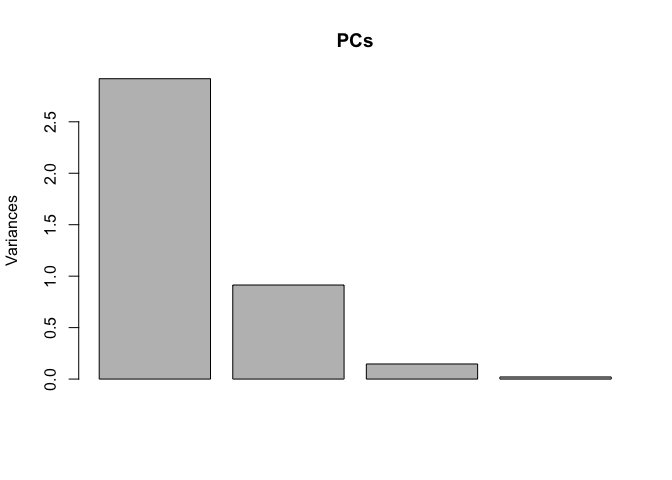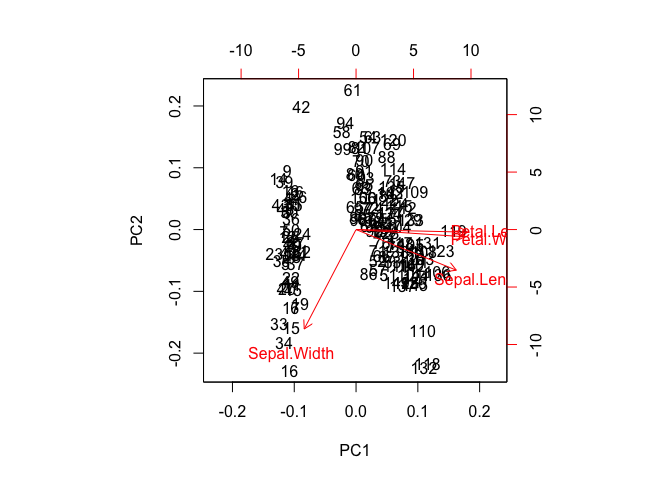The model object has quite a bit under the hood:
library(pls)
#>
#> Attaching package: 'pls'
#> The following object is masked from 'package:stats':
#>
#> loadings
test <- iris[,c(1:4)]
model <- pcr(Sepal.Length ~ ., data = iris, scale = TRUE, validation = "CV")
summary(model)
#> Data: X dimension: 150 5
#> Y dimension: 150 1
#> Fit method: svdpc
#> Number of components considered: 5
#>
#> VALIDATION: RMSEP
#> Cross-validated using 10 random segments.
#> (Intercept) 1 comps 2 comps 3 comps 4 comps 5 comps
#> CV 0.8308 0.5114 0.5067 0.3935 0.3288 0.3137
#> adjCV 0.8308 0.5110 0.5062 0.3930 0.3284 0.3130
#>
#> TRAINING: % variance explained
#> 1 comps 2 comps 3 comps 4 comps 5 comps
#> X 56.20 88.62 99.07 99.73 100.00
#> Sepal.Length 62.71 63.58 78.44 84.95 86.73
str(model)
#> List of 19
#> $ coefficients : num [1:5, 1, 1:5] -0.118 0.226 0.226 0.018 0.19 ...
#> ..- attr(*, "dimnames")=List of 3
#> .. ..$ : chr [1:5] "Sepal.Width" "Petal.Length" "Petal.Width" "Speciesversicolor" ...
#> .. ..$ : chr "Sepal.Length"
#> .. ..$ : chr [1:5] "1 comps" "2 comps" "3 comps" "4 comps" ...
#> $ scores : 'scores' num [1:150, 1:5] -2.21 -1.87 -2.04 -1.9 -2.28 ...
#> ..- attr(*, "dimnames")=List of 2
#> .. ..$ : chr [1:150] "1" "2" "3" "4" ...
#> .. ..$ : chr [1:5] "Comp 1" "Comp 2" "Comp 3" "Comp 4" ...
#> $ loadings : 'loadings' num [1:5, 1:5] -0.3024 0.5785 0.5788 0.0459 0.4866 ...
#> ..- attr(*, "dimnames")=List of 2
#> .. ..$ : chr [1:5] "Sepal.Width" "Petal.Length" "Petal.Width" "Speciesversicolor" ...
#> .. ..$ : chr [1:5] "Comp 1" "Comp 2" "Comp 3" "Comp 4" ...
#> $ Yloadings : 'loadings' num [1, 1:5] 0.3912 -0.0608 -0.4415 1.1631 0.9457
#> ..- attr(*, "dimnames")=List of 2
#> .. ..$ : chr "Sepal.Length"
#> .. ..$ : chr [1:5] "Comp 1" "Comp 2" "Comp 3" "Comp 4" ...
#> $ projection : num [1:5, 1:5] -0.3024 0.5785 0.5788 0.0459 0.4866 ...
#> ..- attr(*, "dimnames")=List of 2
#> .. ..$ : chr [1:5] "Sepal.Width" "Petal.Length" "Petal.Width" "Speciesversicolor" ...
#> .. ..$ : chr [1:5] "Comp 1" "Comp 2" "Comp 3" "Comp 4" ...
#> $ Xmeans : Named num [1:5] 7.014 2.129 1.573 0.705 0.705
#> ..- attr(*, "names")= chr [1:5] "Sepal.Width" "Petal.Length" "Petal.Width" "Speciesversicolor" ...
#> $ Ymeans : Named num 5.84
#> ..- attr(*, "names")= chr "Sepal.Length"
#> $ fitted.values: num [1:150, 1, 1:5] 4.98 5.11 5.05 5.1 4.95 ...
#> ..- attr(*, "dimnames")=List of 3
#> .. ..$ : chr [1:150] "1" "2" "3" "4" ...
#> .. ..$ : chr "Sepal.Length"
#> .. ..$ : chr [1:5] "1 comps" "2 comps" "3 comps" "4 comps" ...
#> $ residuals : num [1:150, 1, 1:5] 0.1228 -0.2129 -0.3458 -0.4986 0.0499 ...
#> ..- attr(*, "dimnames")=List of 3
#> .. ..$ : chr [1:150] "1" "2" "3" "4" ...
#> .. ..$ : chr "Sepal.Length"
#> .. ..$ : chr [1:5] "1 comps" "2 comps" "3 comps" "4 comps" ...
#> $ Xvar : Named num [1:5] 418.65 241.53 77.86 4.91 2.04
#> ..- attr(*, "names")= chr [1:5] "Comp 1" "Comp 2" "Comp 3" "Comp 4" ...
#> $ Xtotvar : num 745
#> $ fit.time : Named num 0
#> ..- attr(*, "names")= chr "elapsed"
#> $ ncomp : num 5
#> $ method : chr "svdpc"
#> $ scale : Named num [1:5] 0.436 1.765 0.762 0.473 0.473
#> ..- attr(*, "names")= chr [1:5] "Sepal.Width" "Petal.Length" "Petal.Width" "Speciesversicolor" ...
#> $ validation :List of 9
#> ..$ method : chr "CV"
#> ..$ pred : num [1:150, 1, 1:5] 4.99 5.11 5.02 5.12 4.96 ...
#> .. ..- attr(*, "dimnames")=List of 3
#> .. .. ..$ : chr [1:150] "1" "2" "3" "4" ...
#> .. .. ..$ : chr "Sepal.Length"
#> .. .. ..$ : chr [1:5] "1 comps" "2 comps" "3 comps" "4 comps" ...
#> ..$ coefficients: NULL
#> ..$ gammas : NULL
#> ..$ PRESS0 : Named num 104
#> .. ..- attr(*, "names")= chr "Sepal.Length"
#> ..$ PRESS : num [1, 1:5] 39.2 38.5 23.2 16.2 14.8
#> .. ..- attr(*, "dimnames")=List of 2
#> .. .. ..$ : chr "Sepal.Length"
#> .. .. ..$ : chr [1:5] "1 comps" "2 comps" "3 comps" "4 comps" ...
#> ..$ adj : num [1, 1:5] 0.2544 0.2485 0.1473 0.1028 0.0908
#> .. ..- attr(*, "dimnames")=List of 2
#> .. .. ..$ : chr "Sepal.Length"
#> .. .. ..$ : chr [1:5] "1 comps" "2 comps" "3 comps" "4 comps" ...
#> ..$ segments :List of 10
#> .. ..$ V1 : int [1:15] 18 128 8 93 76 85 113 129 112 60 ...
#> .. ..$ V2 : int [1:15] 59 26 149 16 41 33 75 38 19 114 ...
#> .. ..$ V3 : int [1:15] 90 101 15 73 143 147 25 138 70 111 ...
#> .. ..$ V4 : int [1:15] 14 40 146 11 69 42 115 148 51 30 ...
#> .. ..$ V5 : int [1:15] 122 65 53 28 102 3 57 17 86 131 ...
#> .. ..$ V6 : int [1:15] 106 56 105 79 120 133 9 71 144 123 ...
#> .. ..$ V7 : int [1:15] 35 119 107 10 45 44 127 134 100 37 ...
#> .. ..$ V8 : int [1:15] 92 23 132 2 34 109 150 104 139 62 ...
#> .. ..$ V9 : int [1:15] 22 137 27 124 7 84 87 74 96 140 ...
#> .. ..$ V10: int [1:15] 6 136 31 89 121 46 13 64 78 116 ...
#> .. ..- attr(*, "incomplete")= num 0
#> .. ..- attr(*, "type")= chr "random"
#> ..$ ncomp : num 5
#> $ call : language pcr(formula = Sepal.Length ~ ., data = iris, scale = TRUE, validation = "CV")
#> $ terms :Classes 'terms', 'formula' language Sepal.Length ~ Sepal.Width + Petal.Length + Petal.Width + Species
#> .. ..- attr(*, "variables")= language list(Sepal.Length, Sepal.Width, Petal.Length, Petal.Width, Species)
#> .. ..- attr(*, "factors")= int [1:5, 1:4] 0 1 0 0 0 0 0 1 0 0 ...
#> .. .. ..- attr(*, "dimnames")=List of 2
#> .. .. .. ..$ : chr [1:5] "Sepal.Length" "Sepal.Width" "Petal.Length" "Petal.Width" ...
#> .. .. .. ..$ : chr [1:4] "Sepal.Width" "Petal.Length" "Petal.Width" "Species"
#> .. ..- attr(*, "term.labels")= chr [1:4] "Sepal.Width" "Petal.Length" "Petal.Width" "Species"
#> .. ..- attr(*, "order")= int [1:4] 1 1 1 1
#> .. ..- attr(*, "intercept")= int 1
#> .. ..- attr(*, "response")= int 1
#> .. ..- attr(*, ".Environment")=<environment: R_GlobalEnv>
#> .. ..- attr(*, "predvars")= language list(Sepal.Length, Sepal.Width, Petal.Length, Petal.Width, Species)
#> .. ..- attr(*, "dataClasses")= Named chr [1:5] "numeric" "numeric" "numeric" "numeric" ...
#> .. .. ..- attr(*, "names")= chr [1:5] "Sepal.Length" "Sepal.Width" "Petal.Length" "Petal.Width" ...
#> $ model :'data.frame': 150 obs. of 5 variables:
#> ..$ Sepal.Length: num [1:150] 5.1 4.9 4.7 4.6 5 5.4 4.6 5 4.4 4.9 ...
#> ..$ Sepal.Width : num [1:150] 3.5 3 3.2 3.1 3.6 3.9 3.4 3.4 2.9 3.1 ...
#> ..$ Petal.Length: num [1:150] 1.4 1.4 1.3 1.5 1.4 1.7 1.4 1.5 1.4 1.5 ...
#> ..$ Petal.Width : num [1:150] 0.2 0.2 0.2 0.2 0.2 0.4 0.3 0.2 0.2 0.1 ...
#> ..$ Species : Factor w/ 3 levels "setosa","versicolor",..: 1 1 1 1 1 1 1 1 1 1 ...
#> ..- attr(*, "terms")=Classes 'terms', 'formula' language Sepal.Length ~ Sepal.Width + Petal.Length + Petal.Width + Species
#> .. .. ..- attr(*, "variables")= language list(Sepal.Length, Sepal.Width, Petal.Length, Petal.Width, Species)
#> .. .. ..- attr(*, "factors")= int [1:5, 1:4] 0 1 0 0 0 0 0 1 0 0 ...
#> .. .. .. ..- attr(*, "dimnames")=List of 2
#> .. .. .. .. ..$ : chr [1:5] "Sepal.Length" "Sepal.Width" "Petal.Length" "Petal.Width" ...
#> .. .. .. .. ..$ : chr [1:4] "Sepal.Width" "Petal.Length" "Petal.Width" "Species"
#> .. .. ..- attr(*, "term.labels")= chr [1:4] "Sepal.Width" "Petal.Length" "Petal.Width" "Species"
#> .. .. ..- attr(*, "order")= int [1:4] 1 1 1 1
#> .. .. ..- attr(*, "intercept")= int 1
#> .. .. ..- attr(*, "response")= int 1
#> .. .. ..- attr(*, ".Environment")=<environment: R_GlobalEnv>
#> .. .. ..- attr(*, "predvars")= language list(Sepal.Length, Sepal.Width, Petal.Length, Petal.Width, Species)
#> .. .. ..- attr(*, "dataClasses")= Named chr [1:5] "numeric" "numeric" "numeric" "numeric" ...
#> .. .. .. ..- attr(*, "names")= chr [1:5] "Sepal.Length" "Sepal.Width" "Petal.Length" "Petal.Width" ...
#> - attr(*, "class")= chr "mvr"
Created on 2020-01-10 by the reprex package (v0.3.0)

